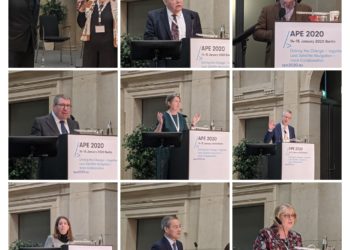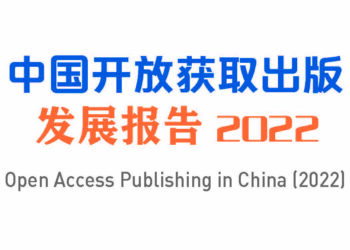Interactions and collaborations between the Chinese research community and international scholarly publishers are as numerous and wide-ranging as at any point in past 20 years, during which China has become the world’s top producer of research papers. Yet in some ways the perception gap between these two groups is widening. Some of our colleagues, peers, and partners in China view open access (OA), research integrity, and the responsibilities of authors, editors, institutions, and publishers quite differently than their counterparts in North America and Europe. Some of this stems from the unique nature of the Chinese research ecosystem, while in other cases, China’s stance points toward a likely evolution of global practices in scholarly publishing. Either way, there is an increasing need to exchange views and come to a more shared understanding of scholarly research and communication.
I recently had the pleasure of chairing the STM/CUJS China Symposium, an event sponsored by the STM Association and the China Society of University Journals which took place on October 16th, ahead of the STM Annual Conference in Frankfurt. For a European event, the symposium was unique in having a majority of both Chinese presenters and Chinese audience members, along with representatives from STM member publishing houses. The presentations and the lively audience discussion session that followed were fresh, informative, and highlighted how wide the gap in perceptions has become.
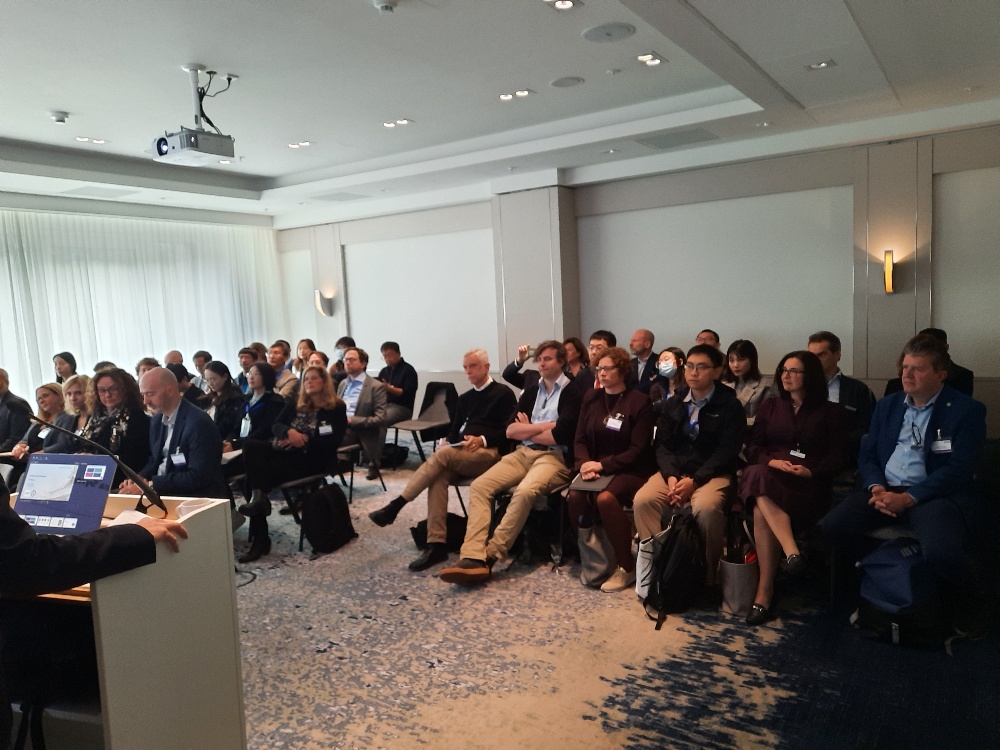
We were fortunate to have four expert panellists addressing key topics facing international and Chinese publishers today:
- Zhang Tieming, President of the Society of China University Journals and Editor-in-Chief of the Journal Publishing Department of Beijing Forestry University, gave a detailed and insightful talk on the status and future directions of OA in China
- Dr Yang Liying, Director of Department of Scientometrics and Research Evaluation of the Chinese Academy of Sciences (CAS) National Science Library discussed the development, methodology, and mission of the influential CAS International Journal Early Warning List
- Chen Zhe, Deputy Director of the Digital Development Center at the China National Publications Import & Export Group (CNPIEC), spoke about the recently established Open Science Promotion Consortiumand its work in the China academic community
- Vickey Gardner, Director of Policy at Taylor & Francis / Routledge and Chair of the STM Open Research Committee explained the role of publishers and the STM Association in supporting research integrity
These presentations (which are available for download), and the discussion between our panel and the audience covered important issues facing scholarly publishing in China, including:
- China’s concerns about the costs of a full transition to Gold OA, which would far exceed what the country currently spends to read and publish research in international journals
- The lack of a national OA mandate in China, and the difficulty, complexity and (again) cost of implementing such a policy across a diverse range of stakeholders
- Continued suspicions about the quality of OA journals and the commercial motivation of international publishers, who are widely seen as making undue profits from Chinese researchers
- Growing resistance to the Gold OA business model
- The increasing influence and impact of journal warning lists in China, their future development and ultimate objective
- How research integrity is perceived in China as largely being the responsibility of publishers to address
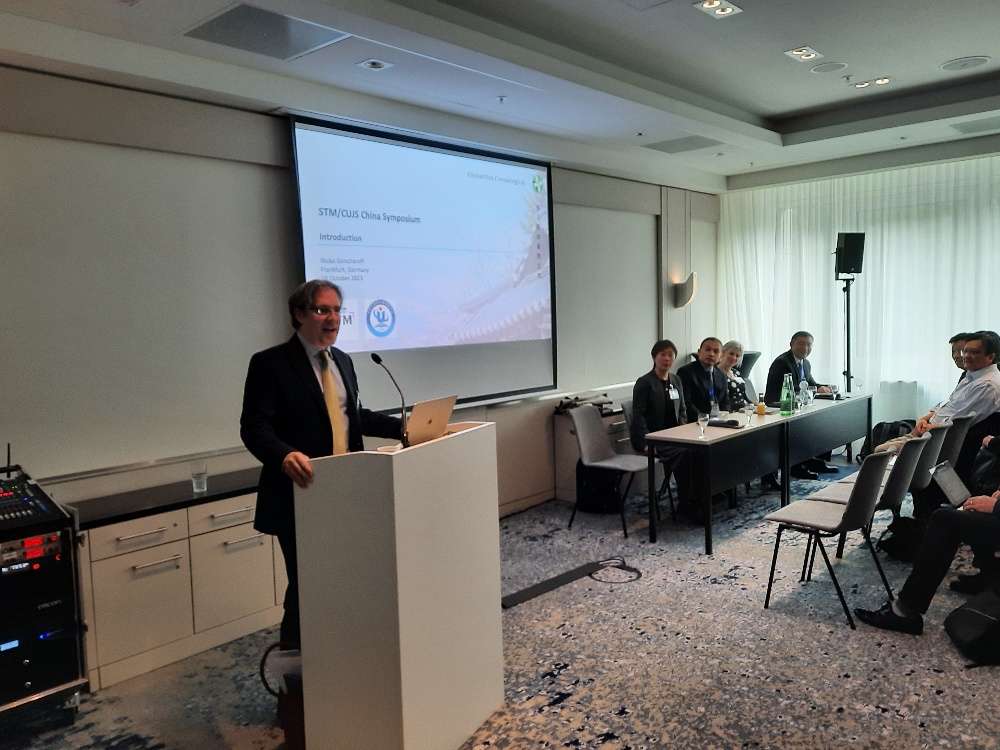
A different take on OA journals, APCs, and research integrity
The Symposium speakers and attendees conveyed the Chinese perspective on all these issues. One audience member, a senior editor at a respected Chinese medical journal, noted that when he first published a paper 32 years ago, the Chinese publisher paid him for the article. He went on to voice a widely held view in China that the increase in what he termed “false papers” – that is, those from paper mills – is due to the profit-driven motivation of OA publishers to increase publications. He did acknowledge the incentives in China that drive researchers to publish in quantity, but felt the larger problem lay with the nature of OA publishing.
He and other Chinese attendees made it clear they think publishers should be largely responsible for upholding research integrity. The panelists and international publisher representatives respectfully challenged this view, contending that the main drivers are the researcher publication incentive system in China and the technical challenges of detecting paper mill output and other instances of academic fraud. Where some in China see the OA business model as the primary cause of academic misconduct, it can be argued that that OA retractions are instead a symptom of a wider problem, as Vicky Gardner of T&F noted.
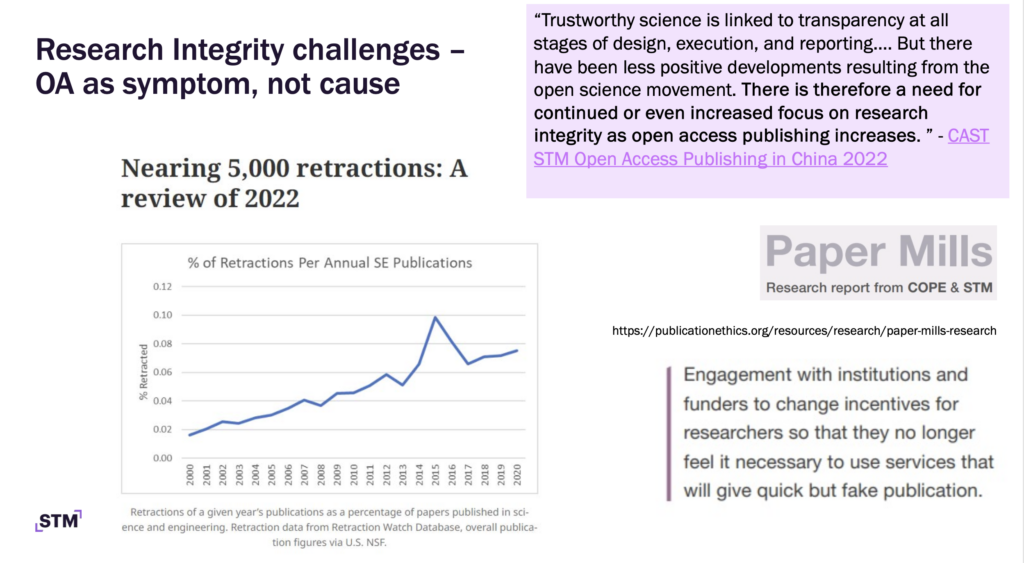
There was consensus that Chinese government efforts to change incentives are critically important, but many of the Chinese symposium participants were nonetheless critical of Gold OA, saying they see it mainly as a way for international publishers to make money rather making research more widely accessible.
Increasing resistance to the Gold OA business model
Gold OA is increasingly being criticized by some in China as yet another western business model that is being imposed upon the country. Universities and research institutions, tasked with making any transition to OA cost-neutral, can be particularly resistant not just to Gold OA, but OA in general. One STM member in the audience related that in discussing alternatives to Gold OA with institutions in China, he would often be told that no other proposed alternatives (waivers, discounts, single fee agreements) were acceptable. (The fact that many Chinese research universities benefit from discounted subscription packages likely underpins this position.) Some Chinese institutions say it’s up to authors to find money, and if they can’t, then publishers should fill the gap.
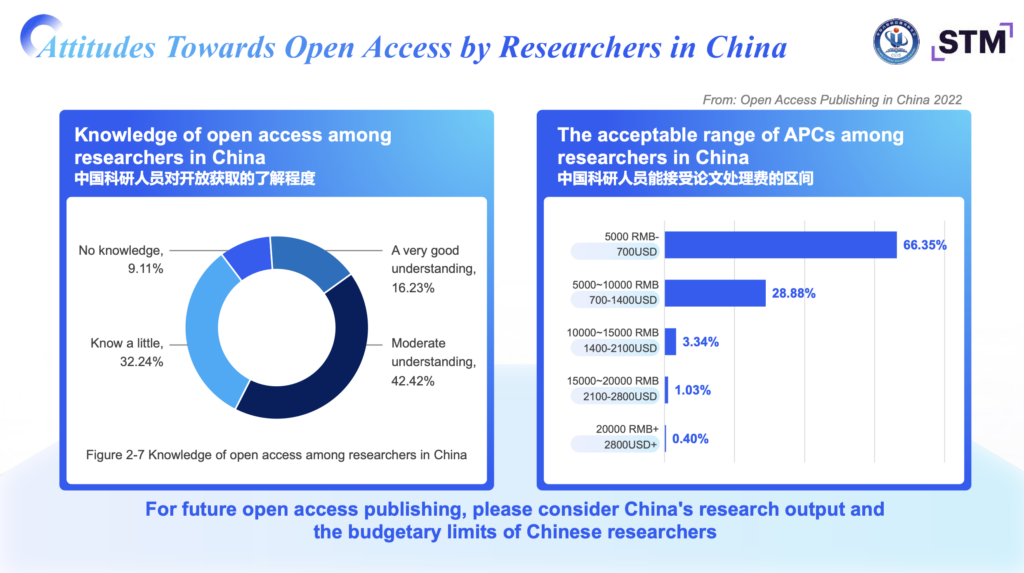
In contrast to many other regions, Chinese researchers and institutions have few objections to the subscription model. This attitude, combined with China’s lack of a national OA mandate, explains why growth of OA publication output from Chinese authors, while impressive, has trailed that of other countries. (As of 2021 OA papers comprised 35.1% of China’s publications output compared with 44.3% for the rest of the world.)
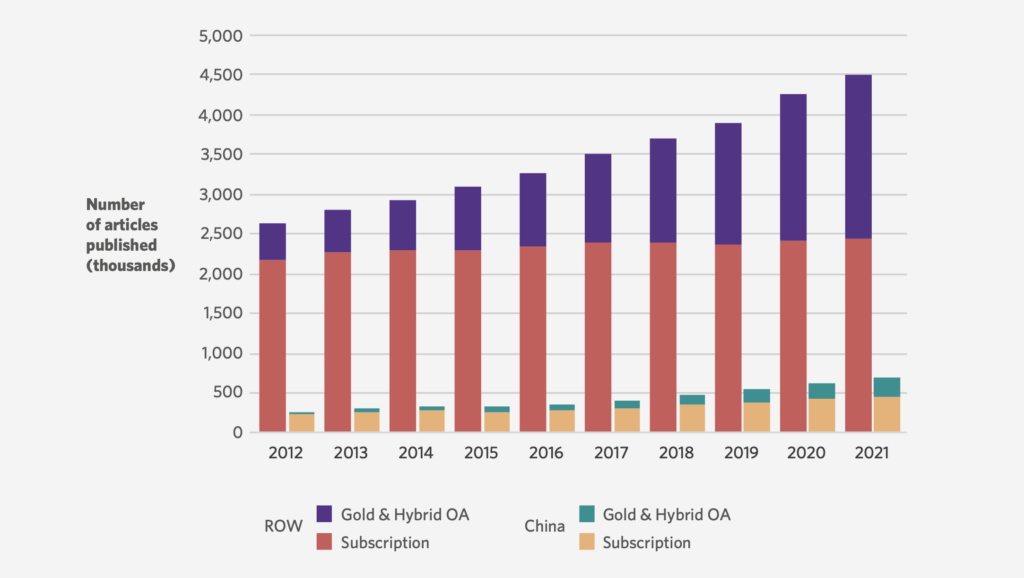
A “reasonable APC”
The massive amount of research produced by Chinese authors means the country still generates a large number of OA papers. As output and article processing charge (APC) costs grow, stakeholders across the Chinese research community are focused on the concept of a “reasonable APC”.
In the past the Chinese government floated ideas of APC targets, such as a figure of $1,200 that appeared on Chinese scholarly social media in 2020-21. The approach now seems to have shifted to evaluating APCs by comparing them to peer journals as well as assessments of journal “quality”.
In his presentation on OA in China, Zhang Tieming described “unreasonable APC journals” as those which “based on their publication volume, influence (H-index, Journal Impact Factor, etc.), and other indicators” have significantly higher APCs than journals meeting similar criteria. Zhang also cited an analysis from GoOA (an open access information and analysis service provided by CAS National Science Library) which contends that 10% of Chinese research between 2019 and 2021 was published in journals with “unreasonable” APCs.
In discussing the CAS International Early Warning List (EWL), Dr Yang noted that the EWL’s “Medium Risk” category considers the APC of a journal and whether it is “reasonable” relative to APCs of peer journals and the journal’s own rejection rate for submitted manuscripts. If a journal has a low rejection rate but a high APC, it could not only be considered “unreasonable”, but could also find itself on the warning list. Confirming the shift away from a fixed APC threshold, the EWL criteria is “a reasonable APC rather than [the] absolute value of [an] APC.”
This perspective from CAS has precedent in the APCheck service, which enables researchers (and publishers) to quickly determine if an APC journal charge is viewed in China as outside the average for titles of similar scope and impact. This APC lookup tool is part of a suite of services provided by GOoA, established in 2013 by the CAS National Science Library to promote OA and the establishment of fair and equitable OA structures and practices (of which APCs are a large part.)
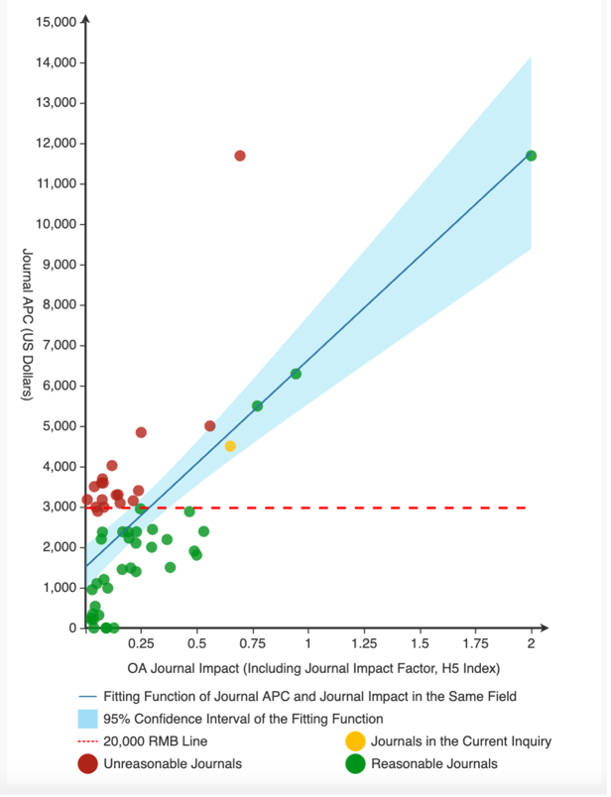
The considerable gap between a “reasonable APC” and current average APCs of most international publishers points to a need for negotiations and compromise between Chinese research institutions and policy makers with international publishers.
National OA mandate not imminent
Until we see what such an overarching compromise looks like, it’s unlikely China will adopt a national OA mandate. Zhang Tieming noted that while APC cost concerns are the main barrier, the complexity and potential risk of transitioning to OA means all the key stakeholders are waiting for someone else to make the first move. He believes any national OA mandate is “far off”, a view shared by a number of the Symposium’s Chinese participants as well as some STM member attendees. This could change of course: new, less-risk averse policy makers and some precedent-setting deals between leading Chinese institutions and some of the largest commercial publishers could perhaps lay the foundation for a national approach to OA over time.
However, the transformative agreements (TAs) that are the most likely vehicle for reaching wider OA agreements that meet the needs of both parties are still rare in China. At the time of writing there were just 16 TAs as well as an agreement with Karger in which subscribers receive an APC discount of 15% for a limited number of papers.
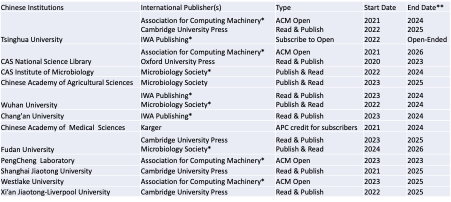
** End date as of 2023 based on current information
Sources: The Charlesworth Group; Open Access Publishing in China 2022, a joint report by the STM Association and the China Association for Science and Technology; Osmanthus Consulting Ltd.
Symposium attendee Mike Evans, CEO of the Charlesworth Group, suggested TA uptake could increase. “Despite the gradual pace of progress to date there is undoubtedly scope for expansion and Chinese institutions are increasingly looking to early adopters such as Tsinghua University and the Chinese Academy of Sciences to gauge the success of their initiatives”, he said.
“There is a growing interest among various institutions to delve deeper into alternative business models and arrangements which shows a willingness to adapt and evolve, which is fundamental to increasing adoption of TAs.” It will be worth paying close attention to the structure of future TAs in China, and the parties involved.
CAS Early Warning List – Confusion, then Communication
Perhaps no issue has been more contentious for international publishers in China than that of journal warning lists, in particular the EWL. Developed as a response to government research assessment reforms, the EWL was launched on December 31, 2020 by the CAS National Science Library’s (NSL’s) Department of Scientometrics and Research Evaluation. The first edition of the list included 65 international journals, classified into tiers of low, medium, and high risk. In the 2021 edition, the number of journals had decreased to 35, while the most recent one, released on January 31, 2023, includes 28 titles, of which just three were also on the original 2020 edition.
Journals placed on the warning list have seen submissions from Chinese authors evaporate. This is due to the inherent influence of a CAS-sponsored list and the fact that many Chinese universities adopt the list wholesale, incorporating it into their own journal guidelines. Researchers are warned that APC funding will not be provided for articles submitted to warning list journals, nor will any such articles count toward academic qualifications or career progress.
The introduction of the EWL was a shock to both international publishers and Chinese researchers, with many viewing it as a punitive measure. There was also some confusion in the research community as to the goals and methodology of the EWL.
At the Symposium Dr Yang made it clear that CAS views these lists as a necessary step on the path to protecting and promoting research integrity. She went on to provide explanations of the different risk levels and their rationale, which many of the international attendees found informative. (See Dr Yang’s presentation for details.) Dr Yang also explained that the reasons for listing a journal, or for removing it, differ by journal as each often has unique circumstances to lead to its having been selected. This went some way toward explaining what to many has been a rather opaque selection process.
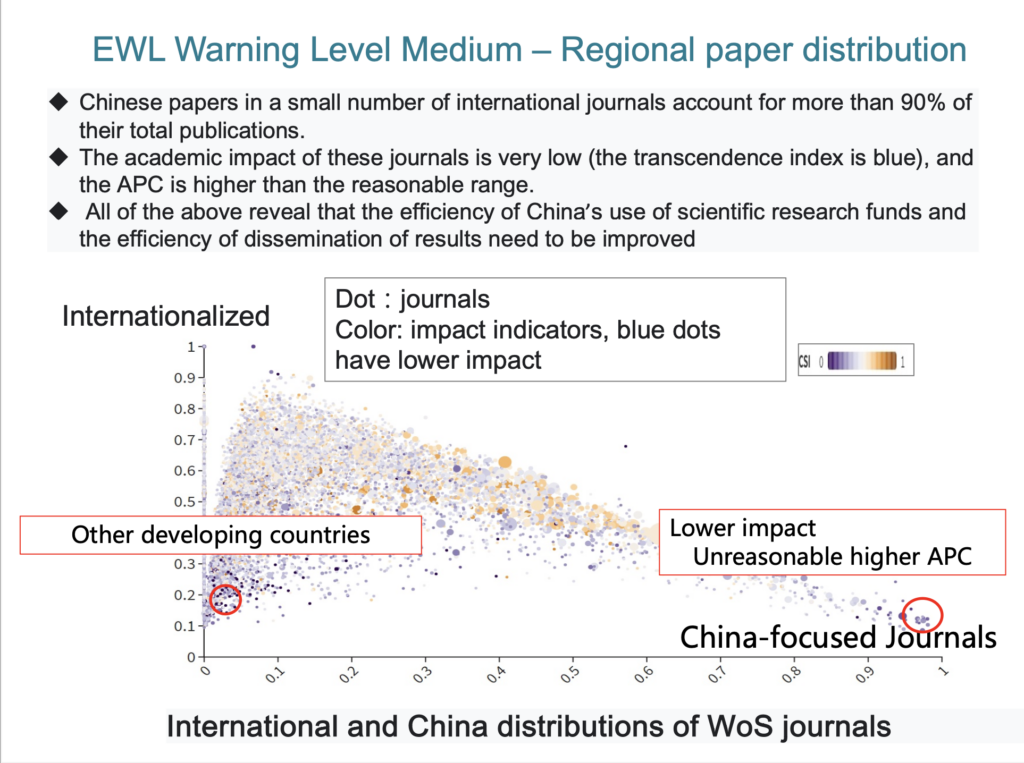
Since 2020 publishers have engaged with CAS and the result has been productive discussions that in some cases have led to changes in journal management as well as collaborations with CAS NSL on promoting research integrity. In addition, the CAS NSL has stepped up broader communications around the EWL. In addition to direct publisher discussions and broader community outreach, CAS NSL has now started to send publishers a draft list of potential EWL journal candidates about six months in advance of the final EWL release. This is designed to enable publishers to take steps to address issues listed by CAS, discuss them with the EWL team and possibly avoid an EWL listing.
As noted above, a major problem with the EWL is that universities will adopt the list wholesale, rather than select certain titles more relevant to their fields of research. Some universities do not update their journal warnings lists annually, which means that journals that have been taken off the EWL may still remain on the universities’ lists. Even more problematic, some Chinese research universities and teaching hospitals have gone a step further and placed all (or nearly all) of the titles of certain publishers on their warning lists. In follow-up discussions Dr Yang stressed this is not an intended or desirable outcome. (I believe international publishers may find CAS NSL willing to support efforts to promote clearer messaging to Chinese research institutions about how the EWL should be used.)
Changing hearts and minds around OA
While they can disagree with some of the Chinese views discussed here, international scholarly publishers must understand and acknowledge them in order to more effectively convey their own perspectives. Some publishers may wonder how to do this, apart from individual discussions with customers and other scholarly research community stakeholders. One option is to join existing efforts in China to address the challenges and opportunities of open science. CAS NSL actively works with international publishers on OA and open science promotion, education, and communication efforts. The China Association for Science and Technology has been working together with the STM Association to develop and exchange knowledge around OA, including releasing the comprehensive report Open Access Publishing in China 2022.
A recent initiative, the Open Science Promotion Consortium (OSPC), aims to bring together publishers, universities, research institutions, science and technology associations and professional service providers to help guide the further development and adoption of open science and open access. Established by China National Publications Import and Export Company (CNPIEC), the Consortium is operating working groups on open access, open data, and open science infrastructure. It currently has 50 members and, in his presentation, CNPIEC’s Chen Zhe, who serves as Director of the OSPC Secretariat Office, actively encouraged international publishers to join, make new contacts and have a say in the development of China’s OA policies and infrastructure.
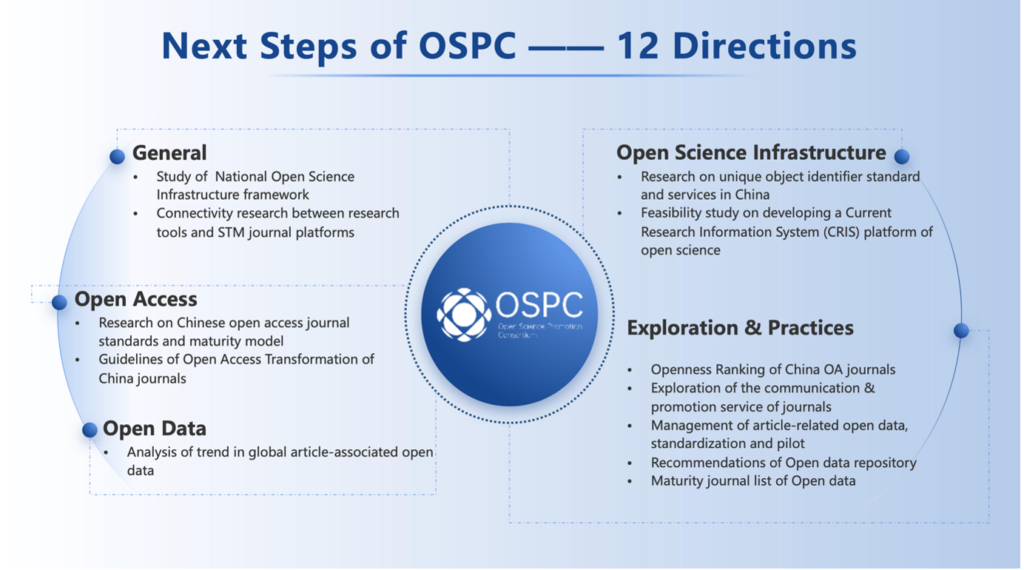
Key Takeaways
Reflecting on the Symposium and the discussions which followed during the STM Annual Meeting, one could identify some key themes:
- China’s increasing concern over APCs suggest that, like the rest of the world, OA in China will likely evolve to encompass several business models, including Gold, Diamond, S2O, and subscription. Further, the subscription business model may not necessarily go away.
- Concerns over Gold OA costs are genuine and increasing. This is a major challenge facing international publishers and the economic constraints facing Chinese research institutions should be acknowledged in business planning. If China can start to benefit from APC revenue, this attitude may change. But even then, it’s safe to say Gold OA will develop differently in China than international publishers might have expected or hoped.
- The international and Chinese scholarly research communities must work together to address the current divergence in views around research integrity if we hope to make real progress in addressing academic misconduct.
- China is keen to continue cooperating with international publishers on OA, research integrity, publisher and author best practices, publishing partnerships, and more. Despite broader geopolitical tensions in recent years, China has repeatedly called for increased international collaboration in scholarly research and publishing, and that message remains consistent from the highest levels of the Chinese government.
Open access and open science are making international publishing more challenging everywhere, and particularly so in China. These challenges will continue and, in some areas, increase, but there is a willingness in China to engage on these issues. International publishers should take advantage of this wherever possible. It will be worth the effort.
Discussion
6 Thoughts on "Guest Post: Mind the Gap – Understanding China’s Perspective on Research Integrity and Open Access"
An excellent overview, Nicko, thanks!
Thanks Rod, much appreciated. We had excellent presenters and an engaged audience, so it’s great to have an opportunity to share some of the outcomes and insights that resulted.
Yes, many thanks. It is very useful to have a sense of the dynamics of scholarly publishing in China. A basic economic analysis of APC-based journal publishing indicates that two major factors would drive increased costs. First is increased transaction costs in collecting payments from authors. Second is the transition from publishing incentives from providing value to readers to providing services to authors independent of reader value. There is an interesting article in the works describing how Latindex works with OA and journal certification to ensure an admirable journal publishing environment in Latin America. It also identifies the source of destabilizing OA publishers. The Canadian government is intent on establishing OA and is just beginning to explore ways other than solely APCs to make that happen. They would benefit from reading your post.
Thanks for providing the additional regional context. I think reader value will still matter, in terms of delivering a service that authors believe will benefit their audience as well as part of the value proposition publishers offer as part of larger institutional deals. But certainly the transition to APC-based publishing is looking financially challenging in some respects. It’s encouraging to hear that the Canadian government is looking at different OA business models. It’s my personal belief that the future of OA will include a range of models and that the subscription model may also survive alongside OA (albeit with access to articles that is increasingly less restrictive).
Thanks Nicko, and excellent summary, do feel it is important and necessary to have this ope dialogue and information sharing with colleagues from China. I have to applaud and thank Caroline Sutton, STM’s Executive Director for initiating and enabling this forum at the STM Frankfurt event, and also for Yan Shuai and Mark Robertson, along with yourself, in coordinating together with the speakers, some good preparation ahead of an excellent event, very pleased to have supported this and been able to attend. Hopefully it may become more regular and event too !
Fantastic article, Nicko!
